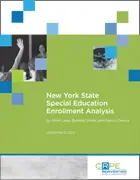Responding to concerns that charter schools do not provide equal access to students with special needs, advocates in districts, states, and courts across the country have sought to improve such access. Lawsuits and complaints allege that some charter schools systematically discriminate against high-needs students. Additionally, the U.S. Government Accountability Office released a report showing that charter schools, on average, serve a smaller proportion of students with disabilities than do district-run public schools. In response, policymakers in some states are looking for ways to better ensure that financial, incentive, and support systems are in place to aid charter schools in providing greater access and services to students with special needs.
This report provides some context to these policy responses by describing the distribution of students with disabilities in New York State charter and district-run schools. The analysis shows that different levels of comparison—state level, school type, district level, and authorizer level—yield different results, and comparisons at high levels of aggregation (such as those made at the state level) mask important information and variation. Whether, and in what ways, charter schools appear to systemically underserve students with special needs depends on how you answer the question, “Compared to what?”
The report’s recommendations suggest that, rather than using blunt policy instruments such as enrollment targets, state policy leaders and authorizers would be wise to invest in research to identify where underenrollment of students with disabilities exists in charter schools and what might explain it, and work with the charter school community to develop innovative strategies to address specific problems.






